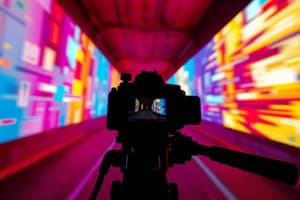Podcast
Questions and Answers
What is the primary function of cinematography in filmmaking?
What is the primary function of cinematography in filmmaking?
- To design the costumes and set decorations
- To create the visual aesthetic and mood of a film (correct)
- To edit the film's pace and sequence
- To create the film's dialogue and script
What type of shot captures a character's face or object in close detail?
What type of shot captures a character's face or object in close detail?
- Close-up Shot (correct)
- Establishing Shot
- Point-of-View Shot
- Over-the-shoulder Shot
What is the term for the horizontal movement of the camera?
What is the term for the horizontal movement of the camera?
- Tilt
- Dolly
- Pan (correct)
- Tracking Shot
What type of lighting creates a rim of light around a subject's silhouette?
What type of lighting creates a rim of light around a subject's silhouette?
Which cinematographer was known for his innovative use of deep focus and low-key lighting?
Which cinematographer was known for his innovative use of deep focus and low-key lighting?
Flashcards are hidden until you start studying
Study Notes
Cinematography
Definition: The art and technique of camera and lighting in filmmaking, responsible for creating the visual aesthetic and mood of a film.
Key Concepts:
- Composition: The arrangement of visual elements within the frame, including placement of subjects, objects, and negative space.
- Camera Angles: The way the camera is positioned to capture a scene, influencing the audience's perspective and emotional response:
- Establishing Shot: A wide-angle shot that sets the scene and establishes the setting.
- Close-up: A tight shot that focuses on a specific detail, such as a character's face or object.
- Over-the-shoulder: A shot that frames one character from behind the shoulder of another character.
- Point-of-View (POV) Shot: A shot that shows what a character is seeing.
- Camera Movement: The way the camera moves to create a sense of dynamic energy or emphasis:
- Pan: A horizontal movement of the camera, left or right.
- Tilt: A vertical movement of the camera, up or down.
- Dolly: A movement of the camera towards or away from the subject.
- Tracking Shot: A shot that follows a character or object as it moves.
- Lighting: The use of light and shadow to create mood, atmosphere, and highlight specific elements:
- High-key Lighting: Bright, even lighting with minimal shadows.
- Low-key Lighting: Dark, moody lighting with prominent shadows.
- Backlighting: Lighting that comes from behind the subject, creating a rim of light around their silhouette.
- Film Stock and Digital Formats: The medium used to capture and display the film's images:
- 35mm Film: A traditional film format known for its warm, grainy aesthetic.
- Digital Formats: Such as HD or 4K, which offer greater flexibility and clarity.
Influential Cinematographers:
- Gregg Toland: Known for his innovative use of deep focus and low-key lighting in films like "Citizen Kane" (1941).
- Vittorio Storaro: A master of cinematography, known for his work on films like "Apocalypse Now" (1979) and "The Last Emperor" (1987).
- Roger Deakins: A contemporary cinematographer, known for his work on films like "No Country for Old Men" (2007) and "Blade Runner 2049" (2017).
Cinematography
- Cinematography is the art and technique of camera and lighting in filmmaking, responsible for creating the visual aesthetic and mood of a film.
Composition
- Composition refers to the arrangement of visual elements within the frame, including placement of subjects, objects, and negative space.
Camera Angles
- Establishing Shot: A wide-angle shot that sets the scene and establishes the setting.
- Close-up: A tight shot that focuses on a specific detail, such as a character's face or object.
- Over-the-shoulder: A shot that frames one character from behind the shoulder of another character.
- Point-of-View (POV) Shot: A shot that shows what a character is seeing.
Camera Movement
- Pan: A horizontal movement of the camera, left or right.
- Tilt: A vertical movement of the camera, up or down.
- Dolly: A movement of the camera towards or away from the subject.
- Tracking Shot: A shot that follows a character or object as it moves.
Lighting
- High-key Lighting: Bright, even lighting with minimal shadows.
- Low-key Lighting: Dark, moody lighting with prominent shadows.
- Backlighting: Lighting that comes from behind the subject, creating a rim of light around their silhouette.
Film Stock and Digital Formats
- 35mm Film: A traditional film format known for its warm, grainy aesthetic.
- Digital Formats: Such as HD or 4K, which offer greater flexibility and clarity.
Influential Cinematographers
- Gregg Toland: Known for his innovative use of deep focus and low-key lighting in films like "Citizen Kane" (1941).
- Vittorio Storaro: A master of cinematography, known for his work on films like "Apocalypse Now" (1979) and "The Last Emperor" (1987).
- Roger Deakins: A contemporary cinematographer, known for his work on films like "No Country for Old Men" (2007) and "Blade Runner 2049" (2017).
Studying That Suits You
Use AI to generate personalized quizzes and flashcards to suit your learning preferences.




